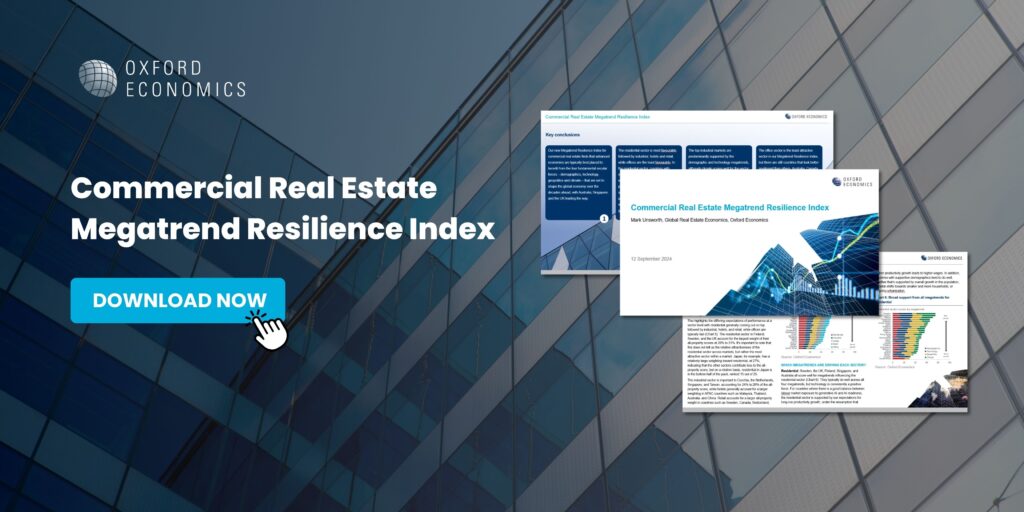The four megatrends that will shape the future of commercial real estate


- Fundamental forces including demographics, Ai, geopolitics and climate change play a key role in building resilience into long-term CRE investment strategies.
- By sector, residential emerges as the most favorable against the critical megatrends, followed by industrial, hotels and retail, with offices being the least attractive.
In the ever-evolving landscape of commercial real estate (CRE), long-term investment strategies must account for fundamental forces that can dramatically reshape the global economy and CRE markets. These forces, known as megatrends, drive technological advancements, transform societies and alter the investment landscape. Our recently launched Commercial Real Estate Megatrend Resilience Index reveals how four critical megatrends—demographics, technology, geopolitics and climate—will shape the future of CRE.

Megatrends favour CRE in advanced economies
When developing this index, we paid special attention to the interplay between these various megatrends.
The reason is that these megatrends do not exist in isolation, but often intersect. In fact, we regularly see real-world situations where megatrends clash, sometimes catching investors out.
For instance, Florida has long been a popular retirement destination, supported by an aging baby boomer population. In recent years, however, Florida has suffered from an extremely rapid increase in insurance costs related to climate change, altering the return prospects from those originally underwritten.
In creating this index, we evaluate each location’s CRE market resilience to the four megatrends, projected through 2050, and assign scores ranging from 0 (least favourable) to 100 (most favourable) at all property level and across five property sectors. This allows us to offer a holistic view of long-run prospects key CRE markets.
Our research shows that advanced economies are generally better positioned for the critical megatrends. Australia, Singapore and the UK are the top three most resilient CRE markets, each with unique strengths.
Australia tops the Megatrend Resilience Index, driven by strong demographics and favourable geopolitical conditions. However, Australia’s high climate transition risk, due to a steep decarbonisation pathway, poses a challenge.
What is the most resilient property sector?
Our Megatrend Resilience Index also breaks down key property sectors based on the most relevant drivers. This allows us to assess the relative attractiveness of various sectors in each country.
Overall, residential is the most favourable sector against the megatrends, followed by industrial, hotels and retail. Offices are the least favourable, although there are still markets that look better placed.
Residential
The residential sector benefits most from supportive demographics and productivity growth. In countries where the there is a good balance between labour market exposure to generative AI and AI readiness, long-term productivity is expected to growth, leading to higher wages, and ultimately benefiting the residential sector.
In the meantime, supportive demographics, whether through population growth, societal shifts towards smaller and more households, or ongoing urbanisation, also play a key role in the prospect of the residential market.
Top 3 most resilient residential markets: Sweden, the UK, Finland
Industrial
A large or growing population means a larger domestic market, which can increase the demand for goods or alter the type of goods consumed. A larger labour force can enhance a country’s productive capacity, enabling it to produce more goods for domestic consumption or export and supporting future demand for industrial space.
From a technology perspective, in wealthy consumer markets such as the US and the UK, ecommerce will continue to play a role as supply chains shift in order to be more local, while the re-shoring of some manufacturing activity and the build out of digital and new energy assets may provide a boost to the demand of industrial property.
On climate, our research shows that transition risk for the industrial sector appears lower than the others due to warehousing/logistics facilities that typically have low energy intensity, lower renovation costs and often possess the ability to add onsite renewables.
In the meantime, supportive demographics, whether through population growth, societal shifts towards smaller and more households, or ongoing urbanisation, also play a key role in the prospect of the residential market.
Top 3 most resilient industrial markets: Singapore, the UK, Australia
Hotel
Economies that have good digital infrastructure and an innovative labour force can enhance productivity in accommodation and food services, boosting output growth for the sector. This has been evident over the past decade, as digital platforms and social media have made it easier for people to discover new destinations, plan trips, and seek out experiences.
From a demographic point of view, rising global incomes, especially in emerging markets, provide a boost to tourism as disposable incomes rise, while ageing populations, typically in advanced economies, provide a growing, wealthy and time-rich consumer group.
Top 3 most resilient hotel markets: Australia, Malaysia, the UK
Retail
Demographics, particularly population growth and income, drive the outlook for retail. Countries with strong population growth – Australia, Sweden and Malaysia – with high incomes – Sweden, Singapore and the US are well positioned for this sector.
In emerging economies, not only are populations increasing, but the size of the middle class is expanding. As disposable incomes increase, consumers substitute low value-added staples with higher value-added goods. Malaysia, China and South Africa all score well on demographics for the retail sector.
Top 3 most resilient retail markets: Australia, Sweden, Singapore
Office
Unsurprisingly, the office sector is the least attractive sector in our Megatrend Resilience Index, but there are still countries that look better positioned over the long run than others. Countries with growing working-age populations are better placed – something that only seven out of the 25 countries in the index are expected to do.
The top five markets are all supported by technology. The office sector is more exposed to advances in generative AI due to office-using occupations typically having a greater theoretical maximum potential for generative AI to automate tasks. The financial and business services sector also has a higher degree of readiness to implement AI and benefit from its capabilities. This could boost output without the worst outcomes for the labour market occurring.
Top 3 most resilient office markets: Australia, Singapore, the US
Download the full Commercial Megatrend Resilience Index report
DownloadRegister for our webinar, ‘Global real estate outlook: Harnessing the power of megatrends’
RegisterThe forecasts and analysis featured in the Commercial Real Estate Megatrend Resilience Index are powered by our Real Estate Economics Service. Trusted by CRE professionals across the world, this service provides insights into the implications of macroeconomic, geopolitical, financial and climate change developments on private and public real estate performance. Click here request a demo today.
Tags:
Related Reports
Click here to subscribe to our real estate economics newsletter and get reports delivered directly to your mailbox

Institutional Real Estate: Australia, Singapore, and the U.K. rank as top markets in Oxford Economics’ Megatrend Resilience Index for Real Estate

Oxford Economics Launches Commercial Real Estate Megatrend Resilience Index

Real Estate Trends and Insights
Read more analysis on real estate performance and location decision-making.
Read more: Real Estate Trends and Insights